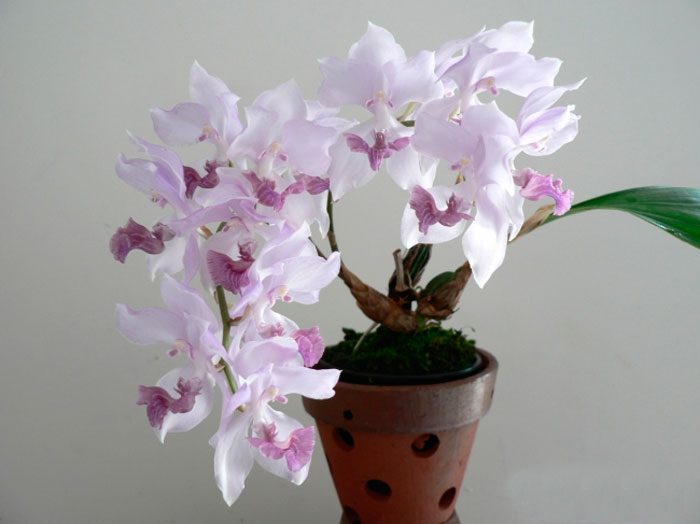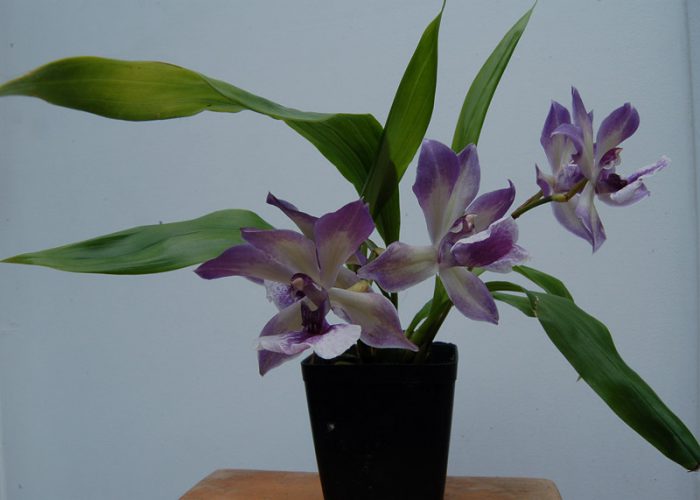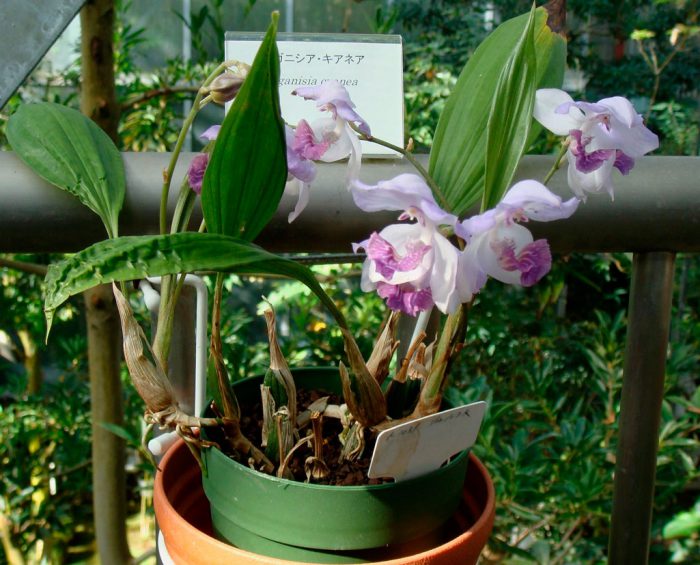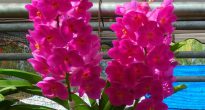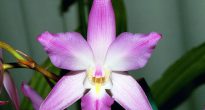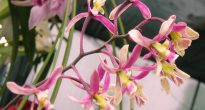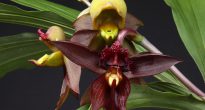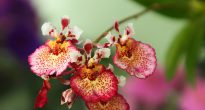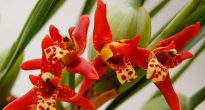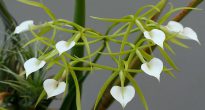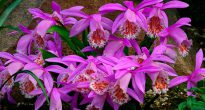A very small genus aghanizia (Aganisia), which is directly related to the orchid family, is also called Acacallis. This genus unites only 4 plant species, which in natural conditions can only be found in the humid forests of South America.
This genus is represented by not very tall epiphytic plants that have a thin long creeping stem (rhizome). Their growth patterns are sympodial. Each young shoot is formed at a distance of 3 to 6 centimeters from the previous one, and at the same time it is located just above it. In this regard, the growth of this stem occurs with a ladder. Narrowed-oval single-leaved dark green pseudobulbs in length reach from 3 to 5 centimeters, and in width - up to 1.5 centimeters. These pseudobulbs are covered almost entirely in film, completely dry, sheaths, under which the rhizome is also hidden. Glossy, leathery, petioled leaves have an elliptically pointed or oblong-lanceolate shape, while longitudinally located veins are clearly visible on the surface. The petiole is 4 centimeters long, while the leaf itself is longer - up to 20 centimeters, and its width is from 4 to 8 centimeters.
This orchid blooms from late winter to early summer. Peduncles are formed at the base of the pseudobulb. They have an arched shape and reach 30 centimeters in length. Such peduncles bear 2-10 zygomorphic flowers. The corolla consists of 2 true petals (petals) located on the sides, 3 sepals (sepals) and a lip (3 modified petals) located below. These flowers have no aroma, and they stay on the plant for a relatively short time from 10 to 12 days.
Content
Caring for the aganizia orchid at home
Since this plant is very demanding to care for, it is not very popular with orchid growers. This kind of orchid is recommended to be grown in a specially equipped room, since in an ordinary room it is very difficult to create conditions as close as possible to natural ones. However, if you wish, you can try to grow aghanizia on your windowsill.
Illumination
Prefers bright lighting, but at the same time it must be diffused. Can also be grown in light partial shade. The plant needs to be protected from direct sunlight.So, it is better to place it on the windowsill of an east or west window, but at certain hours the flower must be shaded from the sun's rays. If there is little light (for example, when placed on a north-facing window), then such an orchid will not bloom.
Temperature regime
For this plant, it is necessary to provide a temperature difference during the day. In this case, the difference between the temperatures should be approximately 7 to 10 degrees. So, during the day it is recommended to maintain the air temperature at 25–32 degrees, and at night - from 18 to 22 degrees. Make sure that the room is not colder than 18 degrees, as in this case aghanizia may die.
It should be remembered that in no case should you transfer such an orchid to fresh air. The fact is that the temperature regime should be the same all year round.
Earth mix
To grow such a flower, you can use blocks or containers filled with a special substrate. To prepare the substrate, you will need coarsely fractionated bark of pine or other coniferous trees, perlite, charcoal and sphagnum. During planting, it is imperative to take into account the fact that the growth of young pseudobulbs occurs by a ladder. As a result, landing must be done on a "slide". It should be borne in mind that old pseudobulbs should be on the surface of the substrate. If you bury them, then this will lead to the formation of rot and death of the orchid. The entire rhizome should be located entirely on the surface of the substrate, while only the root system should be buried in it.
The block is a large piece of pine bark. On its surface, you need to securely fix the roots of the flower, but before that they should be wrapped with coconut fiber or sphagnum, while the layer should be thin enough.
How to water
How often watering should be done directly depends on how the aghanizia is grown. So, when growing on blocks, more frequent watering is required than in a pot. Watering is recommended by immersion method. To do this, immerse a container with a plant or a block in a bowl filled with water and wait a third of an hour. During this time, the velamen, covering the roots and having a porous structure, must absorb a sufficient amount of moisture. Then the orchid is taken out of the basin, but before you put it in place, you need to wait until all excess liquid is drained. Watering aghanizia, experts advise, only after the bark is completely dry.
For irrigation, use soft water at room temperature, which must be well settled before that. If the water is hard, then it can be filtered or mixed with a small amount of citric or acetic acid (while the taste of the liquid should not even be slightly sour). It is not recommended to use boiled water for irrigation.
Humidity
In order for the plant to grow and develop normally, it needs high humidity in the room, as well as warmth. This is especially true for those orchids that are grown on blocks, they simply need a moisture content of at least 70-80 percent. When growing in a pot, the plant will have enough air humidity and 50-55 percent, but this is only if it is properly and timely watering.
If you do not have an orchidarium, then you will have to increase the humidity with household humidifiers or steam generators. In the event that this is not possible, it is recommended to put the container in a pallet filled with pebbles or expanded clay and not very much water. It is recommended to put a layer of moss on top of the substrate, and it must be moistened regularly.
Since various fungal diseases can develop in stagnant, warm and damp air, in order to avoid this, the room where the orchid is located must be systematically ventilated.
Transplant features
The transplant is carried out only if necessary, because the root system reacts very badly to such a procedure. So, a very overgrown plant, which has ceased to fit in a pot or on a block, can become a reason for transplanting.
Fertilizer
Aghanizia has rather delicate roots and is highly sensitive to a variety of chemicals and salts. In this regard, it is necessary to feed such a flower very carefully. So, feeding should be carried out 1 time in 4 weeks. To do this, use a fertilizer designed specifically for orchids (take ¼ part of the dose recommended on the package). The plant also needs foliar feeding, which should be carried out between the main ones. To do this, use a solution of the same fertilizer, only it should be even weaker.
Reproduction methods
This kind of home-grown orchid can only be propagated by division. Moreover, after the rhizome is divided, there should be at least 3 mature pseudobulbs on each section.
Propagated by seeds and meristem (cloning) only in industrial conditions.
Diseases and pests
Most often, such a plant dies due to the fact that it is kept in conditions that have nothing in common with the usual natural ones. So, the following violations in care are very common: the room is too hot or cold, intense or poor lighting, too long periods of drought, lack of daily temperature changes, rare ventilation, drafts.
Main types
Only two types of aghanizia are most popular among domestic florists.
Blue Aganisia (Aganisia cyanea)
This plant is one of the most spectacular among the huge number of members of the orchid family. Its main distinguishing feature is the beautiful blue color of the flowers. Such flowers are relatively small, their diameter is usually 5-6 centimeters, but they are incredibly beautiful and can compete with the Cattleya, which is the recognized queen (their flowers have a similar shape). Sepals are slightly wavy and are located at an angle of 120 degrees in relation to each other. They are the same length, but the one above is ovoid and wider than the oval lateral ones. The lip and petals are also positioned in relation to each other at an angle of 120 degrees. Rounded petals are narrowed at the base, but at the same time they are somewhat wider and shorter than the sepals. The lip protrudes forward. It has outgrowths-wings located on the sides, and it also has a narrowing at the base and is outwardly similar to a concave shovel, the edges of which are fringed or slightly cut.
Beautiful Aganisia (Aganisia pulchella)
This species is more compact than blue aganizia. The length of the peduncles does not exceed 15 centimeters, they have 2–5 not very large (up to 4 centimeters in diameter) flowers, painted in a whitish-cream shade. Elongated-oval sepals and petals are similar in shape, they are narrowed at the base and have a sharp point at the tip. The sepals are 2 centimeters long and 1 centimeter wide. The petals are narrower and not as long. The shape of the lip is similar to a small, concave spade that is sharpened at the tip. At the base there is a not very large growth, painted in burgundy, and the middle is yellow.

